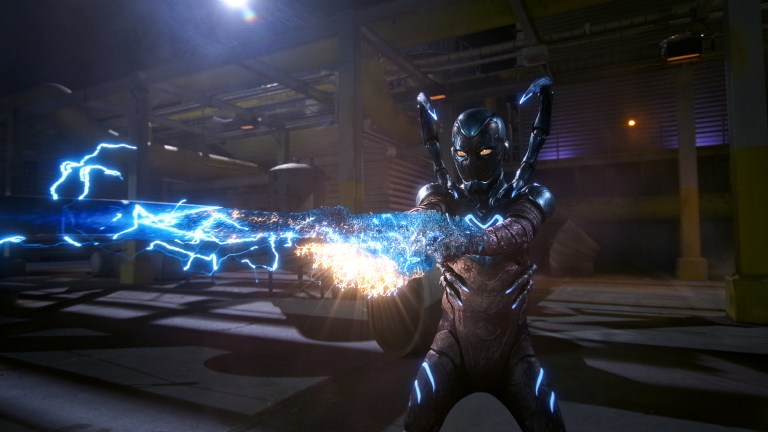Blue Beetle Just Brought One of DC’s Weirdest Characters to the Big Screen
Blue Beetle digs deep into DC Comics history, including one of the weirdest Jack Kirby creations.

This post contains spoilers for Blue Beetle.
Even ten years ago, few would have guessed that the Blue Beetle would be in a movie, let alone the star of one. Both the current Blue Beetle Jamie Reyes and his predecessor Ted Kord have been fan favorites since the 80s, when the latter became a member of Justice League International. But Blue Beetle is hardly the only DC Comics deep cut in the film.
Throughout the movie, the villainous Victoria Kord (Susan Sarandon) touts her company’s newest invention, a battle suit termed OMAC, which stands for One Man Army Corps. Created by Jack Kirby during his time at DC Comics in the 1970s, OMAC is one of the legendary artist’s strangest characters, someone who has been radically reimagined several times since his first appearance.
OMAC made his debut in 1974’s OMAC #1, written and penciled by Kirby, with letters and inks by Mike Royer. Set at some point in a non-specific future (“THE WORLD THAT’S COMING!!” declares the opening narration), OMAC is the creation of the Global Peace Agency (GPA), a literally faceless group of overseers who police the world. Fearing that the violence of war will disrupt the peace they’ve cultivated, the GPA chooses weakling Buddy Blank as their hero, using the super-satellite Brother Eye to imbue him with amazing powers.
Kirby intended OMAC to be a futuristic update of one of his oldest characters, Captain America, whom he co-created in 1940 with Joe Simon. Not only does Blanks share Rogers’s humble begins and everyman spirit, but Kirby draws their fighting style in a similar way, with OMAC hurling his body at dozens of enemies, like a human bowling ball.
But that’s where the similarities end. Clad in a blue and gold outfit with a strange eye emblem on his chest, his connection to Brother Eye, OMAC is best defined by the giant black mohawk on his head. The mohawk represents Kirby’s ongoing interest in the counter-culture, the movement that also inspired the Forever People and even Mr. Miracle. Kirby’s interest in leftist politics can also be seen in the plots of his OMAC comics, surrealistic tales that pit the hero against a cabal of superrich warlords or factories making plastic pseudo-people.
OMAC was canceled after eight issues, but other creators brought the character back, with Denny O’Neil making Blanks the grandfather of the even more futuristic hero Kamanda, the last boy on Earth. Later creators such as Jim Starlin and John Byrne would expand on the mythos, eventually leading Blanks to be integrated into the mainstream DC Universe as an aged professor (complete with a blond grandson), who becomes OMAC at the end of the series Countdown to Infinite Crisis.
Rather than bring OMAC back to his roots, Infinite Crisis offered the most notable revision of the character. In this story, Brother Eye was created by Batman at his most paranoid as a way to monitor superhuman activity. When a threat presented itself, Brother Eye sent nanobots to transform regular people into Observational Metahuman Activity Constructs aka OMACs. These OMACs were more streamlined in design, with blue figures with the eye logo and, most importantly, a mohawk-like fin protruding from the head.
In Blue Beetle, writer Gareth Dunnet-Alcocer and director Ángel Manuel Soto takes OMAC even farther from his roots. The Kord OMACs are simply high-tech body armor, eventually augmented by the alien scarab Khaja-Da, which attaches itself to young Jamie Reyes (Xolo Maridueña). By the end of the film, Victoria’s henchman Carapax takes on the OMAC power, complete with a blue sheen replacing his red armor.
Unfortunately, the OMACs of Blue Beetle lack the distinctive mohawk of the comics, not even in the form of a stylish fin. However, the movie’s surprisingly radical politics and suspicion of the upper classes (at least until the final moments) carry on the legacy of Kirby’s creation.
